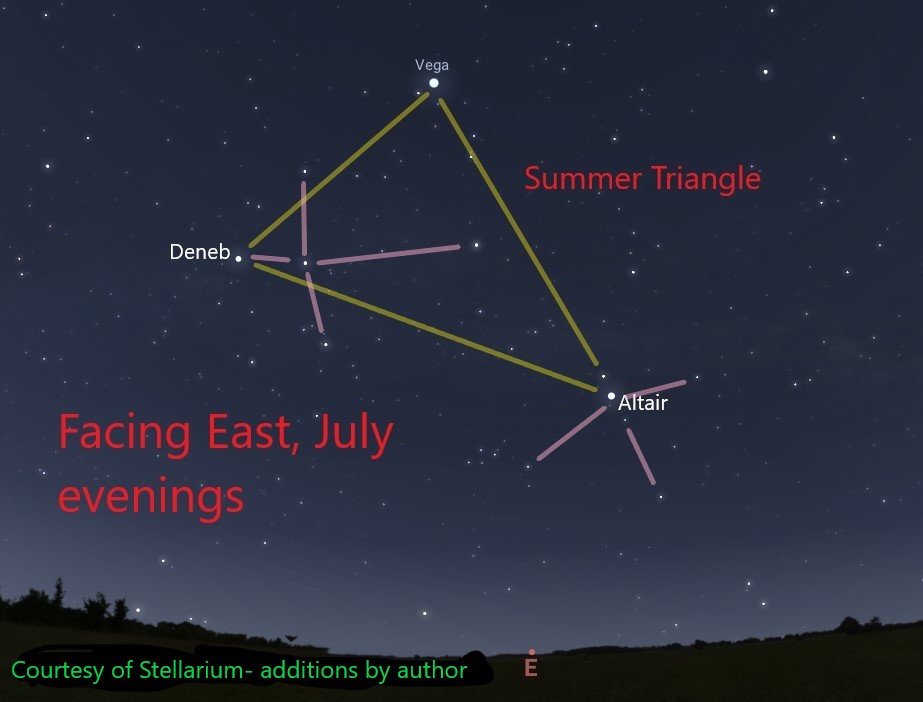Try the Triangle
The sun sets late during the summer months in the northern hemisphere, so that you need to stay up fairly late in order for the sky to be fully dark. Good news- my featured star group for this month, the Summer Triangle, is quite bright and can be seen as early as 45 minutes after sunset, or halfway through official twilight. Oddly enough, like the Big Dipper, which is part of Ursa Major, the Summer Triangle is not a constellation. It is an asterism, an unofficial grouping that stargazers have noticed and has become popular.
If you face east on these July evenings, a bright star quite high up will stand out. It is Vega, relatively close to Earth at 25 light years away. Look very close and Vega may look just slightly bluish white to your eyes, indicating its hot temperature. Compare Vega to almost equally bright Arcturus, in the west, which to me seems a bit yellowish orange in tint. By the late evening Vega will appear almost exactly straight up. A faint parallelogram of stars appears below Vega, making up the constellation Lyra, the Harp. If you have too many lights in your location, try taking out a small pair of binoculars to pick up some of the fainter stars that are easily visible to the naked eye from darker sites.
The second member of the triangle is Altair, one of the closest stars visible to the naked eye at just 16 light years distance. You can tell your teenager that the light from Altair left just about the time that they were born. Altair is believed to be about twice the size of the Sun and eleven times more luminous. It shines to the lower right of Vega and is flanked by two dimmer stars, sort of a summer version of Orion’s belt.
Last, dimmest, but certainly not least is Deneb. You can imagine a cross on its side- the Northern Cross, out of Deneb, the three stars in a vertical line to its right, and the star that is almost halfway between Vega and Altair. With even more imagination, you can imagine a bird, as these are the stars of the constellation Cygnus, the Swan. You can learn more about these stars in the September 2021 and August 2022 editions of this blog. The most amazing thing about Deneb is its staggering distance, as the light you see is estimated to have left 2,600 years ago, or nearly three times Methuselah’s age! It may be as much as 200,000 times more luminous than our Sun, which would be visible only with a powerful telescope if it were as distant as Deneb.

Three bright stars form the Summer Triangle, which dominates the season’s night skies
Join us for our next two Gateway to the Stars programs! On July 5, our Sky Ranger will provide a planetarium style tour of the night sky in “Summer Star Trek”, held at 7 pm in our Education Classroom, rain or shine. On August 2, come to Tucker Theater at 6 pm for our annual “Kids Explorer Night.” Renowned storyteller Bobby Norfolk will tell star tales of various cultures, while our Sky Ranger will assist children 5-13 in earning a Junior Ranger Night Explorer patch customized to our Park. Both programs will be followed by free telescope viewing of the Moon and other objects on our Entrance Plaza, weather permitting.
